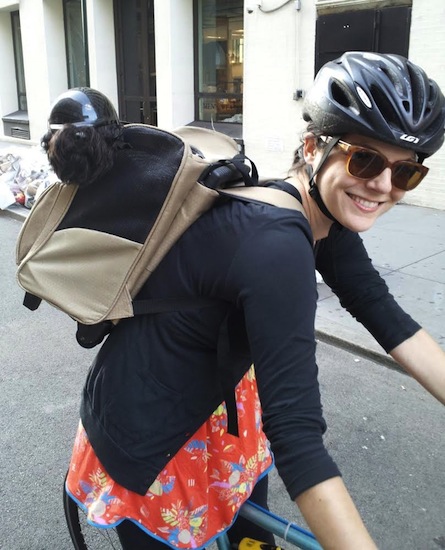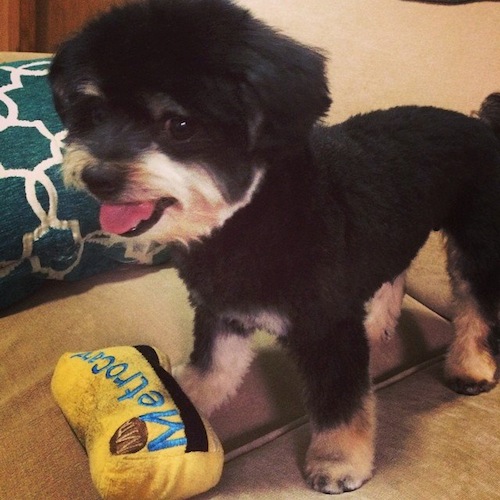
I love Amos, my Yorkiepoodle, oodles and oodles. But I’ve never known him to be able to hold down a job. Sure he is cuddly (sometimes), lets me know when someone is at the door and provides good Instagram fodder. But ours is largely a parasitic relationship, as dog poop sucks as a form of currency. Fortunately, poverty isn’t so bad when you have a roommate to lick your tears.
I work as a dog trainer at the School for the Dogs and am surrounded by a lot of nerdy dog types, all of whom don’t skimp when it comes to their doggie pals. But that doesn’t mean we spend a bundle. There are many, many things you can do to be a great dog owner without going broke. Here are some tips my scrappy dog-professional pals and I have come up with over the years.
GEAR
Stop the poop bag habit. There are a few ways to do this. Sure, you can start saving your grocery bags; if you have a small dog with modest poops, you can cut up the bags to get more uses out of them. If you have a big dog, this might mean more Shoprite visits than necessary. For those in that camp, I suggest getting the Sunday New York Times. For $5, you can pick up excrement for a week. Viva, print journalism!
Stock up on leashes at American Apparel. They usually have them on sale — anywhere from $1 to $5. I like their leashes because they’re pretty cheap and also they have a trigger snap, which is generally considered (by those who have opinions about such things) to be safer than the standard clasp you see on most leashes. If you have a dog who is a leash chewer, you will go through fewer leashes with a metal chain between the leash and your dog’s collar.
Make your own toys. I’m a huge fan of “work to eat” toys, which can help dogs become better problem solvers, keep them occupied, and also promotes slower eating, which is healthier than snarfing. Really, there is no downside to these kinds of toys except for the fact that some of them are quite pricey. So, duh: Make your own:
• Put treats in a muffin tin, then cover them with tennis balls. Crazy fun.
http://youtu.be/N4MwI3GSdqo
• Get a big cardboard box, scrunch up some butcher paper, and toss in your dog’s food or some treats (or wrap up a peanut butter-filled Kong and throw that it in). I swear, this is like the dog version of Candy Crush.
• Cut a small hole in the side of an empty water bottle, and thread a knotted sock or a piece of rope through the hole and bottle rim, then knot again. Fill with kibble or treats. (This is a cheap-o version of the Tug-A-Jug, but actually better liked by many dogs because they have a thing for crinkly water bottles)
• When your dog tears stuffing out of a toy, replace it with an old t-shirt, or stuff his other toys inside the torn toy. You can also let them tear out a toy’s filling over and over by creating a “Destruct-o-ball”: stuff a Hollee roller type toy with treats wrapped in rags.
GETTING A DOG
• Consider becoming a part-time dog parent. At School For The Dogs, we run NY Dog Share, which is a listing of people who would like to spend time with a dog but cannot own one themselves. Some of them will come volunteer to go hang out with dogs for free; some ask for some small honorarium. This is a nice way for the non-dog owner to enjoy the pleasures of pet ownership without the financial responsibility, and it’s great for pet owners who have dogs who are anxious if left alone during the work day. There is also PAWS, which pairs volunteer pet-lovers with pet-owners who are homebound or otherwise infirm and need a hand taking care of their furry pals. (If you’re as interested in the green as you are in the animal love, you can use DogVacay, which is like an AirBnB for dogs.)
• Do your research. If you’re looking to purchase a puppy from a breeder, some thoughtfulness early on can reduce the chance that you’ll need to invest in having a dog trainer or vet hospital solve your problems later. Start with researching to find a good breeder. How do you know what a “good” breeder is? Well, for one thing, avoid high volume breeders and ones that do not offer a lifetime return policy (they should be interested enough in the dog’s well-being to agree to take back a dog at any time, for any reason). You also want to make sure you see where the puppies were reared. Puppies raised in home-like environments rather than in kennels out back are more likely to be getting more of the important socialization that young dogs need in order to thrive later on. It is also good to ask the breeder if they do temperament testing, as this kind of evaluation can help (for instance) keep a very sound-sensitive puppy from a city apartment, or a rough one from a home with kids. Lastly, make sure you can meet the puppy’s parents and grandparents, if possible. You want to see that you like their temperaments and that they are healthy and long-lived.
• If you go to a pet store (which I don’t suggest doing), ask for a steep discount for any dog that is older than 16 weeks old. These dogs are on the outer edge of the important “socialization period.” This means you’ve missed the ideal window in which you can introduce them to all the things you’re going to want them to know in their lives. They might still end up becoming great dogs, but it’s a good reason to insist upon a discount. Also, whenever purchasing at a store, make sure to know what their policies are if you change your mind or if your pet gets sick (or dies) soon after you take him home. These might be tough questions to ask, but they can save you a lot of green (and grief) later.
• If you are considering rescuing a dog, think about fostering first. If you’re not sure that you want to make a lifelong commitment to a dog, this can be a good way to get your fix and provide a real service to a dog that might otherwise be in a shelter (or dead). A good fostering organization will often pay for the daily costs of keeping the dog, and for any vet care or grooming that will be needed. Personally, I think that the younger a rescue dog is, the better. They’ve had less time to develop behaviors or anxieties that may later prove troubling (and expensive). Look for a rescue that will ask you a lot of questions about your lifestyle to make sure the dog and you will be a good fit, and will tell you a great deal about your potential dog’s personality and preferences. We’ve seen too many needy dogs be placed with people who are out 10 hours a day, skateboard-lungers living on Tompkins Square, etc.
• Get a breed that sheds. Unless you have a clippers and are feeling brave, a shedding-dog will save you a few hundred dollars a year in grooming fees. I actually do clip my non-shedding dog myself most of the time, but this is because he is mellow about being groomed and I feel he’d be adorable even if I totally messed up. Alternatively, you can take grooming lessons. My friend Jay Andors offers these. For the less than the amount you’d spend on a year of grooming, he can show you how to groom your own dog for life.
• Go small. Big dogs are wonderful (big pit bull fan here!) and some large breeds can make excellent apartment dogs, but the fact is that they tend to a eat a lot. It’s much less expensive to feed a small dog. Also: It’s a lot harder to get around cheaply with a big dog. Having a car becomes hugely helpful, and those cost even more than dogs. If you need to leave town, it’s usually easier to park a small dog at a friend’s house if you have to, rather than having to pay for boarding or a sitter. Small dogs also are often portable. Being able to often bring a dog with you can mean that you will have to spend less on dog walkers, or on a having a trainer come help you deal with the separation anxiety issues that might pop up if your pup has too much alone time.
• If you have your mind set on a pure breed, check the AKC website for recommended breeders, and peruse their Canine Health Foundation, as this can give you a good rundown on diseases that can be common to a breed (and draining on your bank account). Ideally you want to pick a breed with a breed club that is actively researching how to weed out congenital issues that might be common.
TREATS

• Buy chicken livers. They cost $2 a pound and can be baked or served raw.
• Make your own jerky treats. Get cheap meat, slice thin, and put in oven at 145 degrees for six hours. You can also do the same with sweet potatoes. And probably lots of other things.
• Cut up a Redbarn food roll to use as treats. Dogs love them and a single $8 roll will last you ages.
• Restuff a toothpaste tube. Cut the end off, rinse it out very well, and then scoop in peanut butter or baby food or cream cheese. Close the top with a binder clip, and let your dog lick the end. Yummers (You could also invest in a reusable tube — I like this one).
FOOD
• Don’t rule out human food. I hear a lot of people complain about the cost of dog food, but a good diet really can reduce likelihood of health problems that are annoying and costly. If you have a well-stocked fridge, you can probably prepare a great dog meal for almost nothing. Dogs evolved to dive our dumpsters; they’re well-suited to eat many of the same things we eat. I have plenty of friends who do this, supplementing stuff they have in the fridge anyway with cheap organ meat and bulk chicken wings and the like. There is a website, BalanceIt, wherein you can plug in what you’re feeding your dog and it’ll help you make sure they’re getting all the stuff they need to stay healthy.
• Buy Evermore. This is sort of a plug, as this is this is the only brand of dog food we sell at our training center. It is made my friends Hanna Mandelbaum and Alison Wiener. This stuff isn’t cheap, but here is what makes it a money saver: Humans can eat it too! There is nothing in it that is so gross that a human wouldn’t tolerate it. Alison and Hanna once ate nothing but their own dog food for a month and neither one got salmonella. I’ve never gone that far, but I did once tuck into a container of it (topped with a chimichurri sauce) and it was good enough that I had seconds.
TRAINING
• Train your dog to file his own nails. Avoid the stress of dealing with nail clippers yourself, and the expense of getting them done at the vet or groomers.
• Try group training. Seek out friends/neighbors who are interested in doing semi-private sessions with a Certified Professional Dog Trainer (you can find one here), as these will provide more one-on-one attention at a cost that is less than a private session.
• Check out Youtube for lots of free training tips. Kikopup is a good place to start.
• Ask your trainer if they give discounts to owners of rescued dogs. We do!
HEALTH
• Brush your dog’s teeth daily. This might seem crazy, but, in the long run it’ll save you a bundle. A professional tooth cleaning and extractions can easily cost close to $1000, and as your dog gets older you might have to do it every year. You don’t even have to buy dog toothpaste: a lot of vets say that just agitating their gums a little is enough.
• Set aside some dough. Open a savings account and get a credit card that offers miles or points. Put a fixed amount of money from each paycheck into the savings account each week — $20 would be a good place to start. When pet medical expenses arise, use your points-card and pay it off from the savings account. You could also get pet insurance, but I hear mixed things about the efficacy of these plans and I’m not completely convinced it is the most financially prudent route. With the savings account/credit card route, you may get a free flight to Europe eventually, and if you have a pet that never gets sick, in the end you’ll have some cash to throw him a really lavish funeral.
Anna Jane Grossman is a dog trainer with The School For The Dogs in the East Village.
2 Comments
Leave a Reply




Great info here, thanks for compiling them all! I definitely need to get going with brushing my dog’s teeth, and I’m totally trying the treats in a box strategy.
here’s a question: how do i get a bunch of free tennis balls?